Medication Administration and Management
VerifiedAdded on 2020/06/06
|9
|2103
|88
AI Summary
This assignment explores various aspects of medication administration and management. It discusses different forms of medications (tablets, liquids, creams, injections), administration devices (compliance aids, inhalers, MDS), safe storage practices to prevent expiry or damage, the importance of authenticity, and proper disposal methods for unused medicines. The text emphasizes responsible medication handling for optimal health outcomes.
Contribute Materials
Your contribution can guide someone’s learning journey. Share your
documents today.
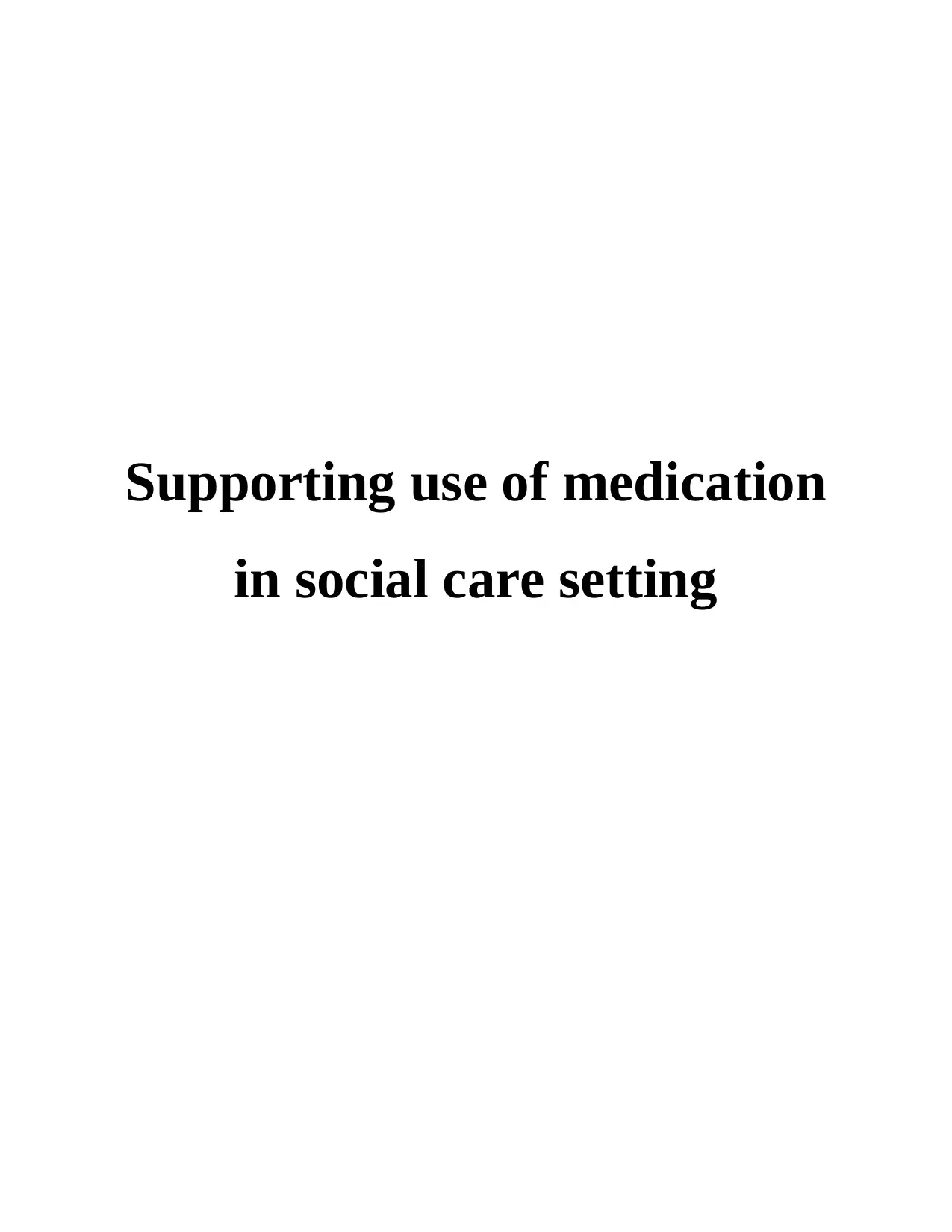
Supporting use of medication
in social care setting
in social care setting
Secure Best Marks with AI Grader
Need help grading? Try our AI Grader for instant feedback on your assignments.
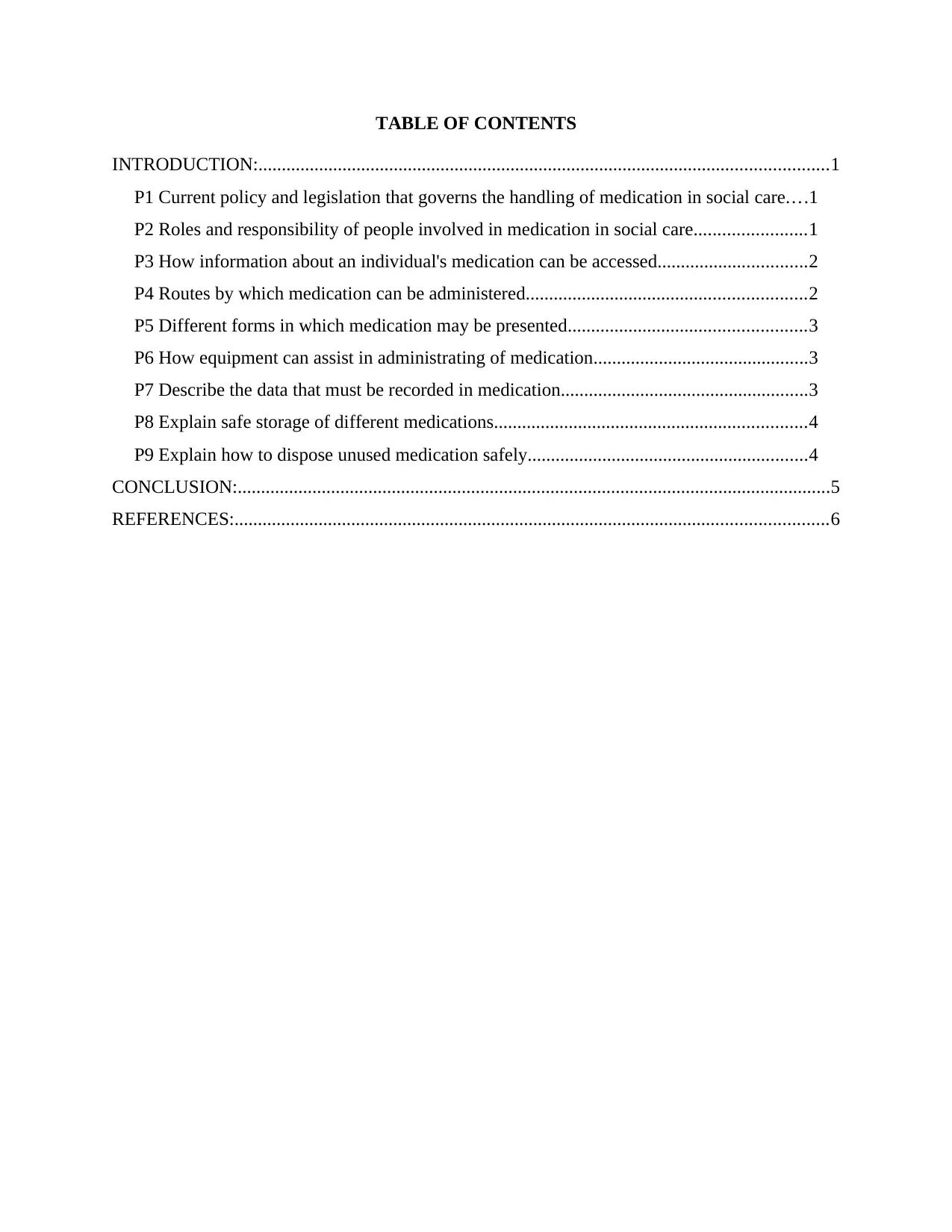
TABLE OF CONTENTS
INTRODUCTION:..........................................................................................................................1
P1 Current policy and legislation that governs the handling of medication in social care....1
P2 Roles and responsibility of people involved in medication in social care........................1
P3 How information about an individual's medication can be accessed................................2
P4 Routes by which medication can be administered............................................................2
P5 Different forms in which medication may be presented...................................................3
P6 How equipment can assist in administrating of medication..............................................3
P7 Describe the data that must be recorded in medication.....................................................3
P8 Explain safe storage of different medications...................................................................4
P9 Explain how to dispose unused medication safely............................................................4
CONCLUSION:...............................................................................................................................5
REFERENCES:...............................................................................................................................6
INTRODUCTION:..........................................................................................................................1
P1 Current policy and legislation that governs the handling of medication in social care....1
P2 Roles and responsibility of people involved in medication in social care........................1
P3 How information about an individual's medication can be accessed................................2
P4 Routes by which medication can be administered............................................................2
P5 Different forms in which medication may be presented...................................................3
P6 How equipment can assist in administrating of medication..............................................3
P7 Describe the data that must be recorded in medication.....................................................3
P8 Explain safe storage of different medications...................................................................4
P9 Explain how to dispose unused medication safely............................................................4
CONCLUSION:...............................................................................................................................5
REFERENCES:...............................................................................................................................6
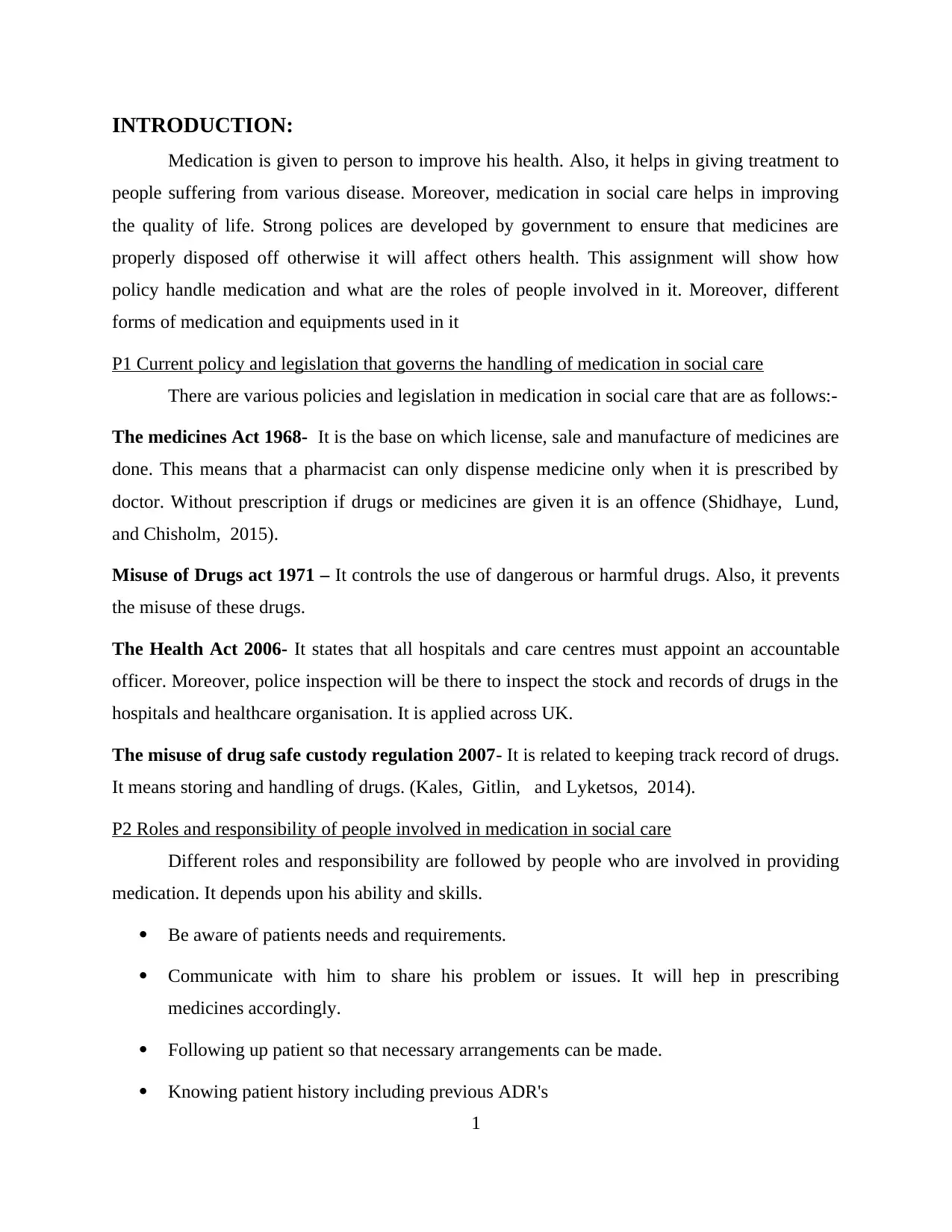
INTRODUCTION:
Medication is given to person to improve his health. Also, it helps in giving treatment to
people suffering from various disease. Moreover, medication in social care helps in improving
the quality of life. Strong polices are developed by government to ensure that medicines are
properly disposed off otherwise it will affect others health. This assignment will show how
policy handle medication and what are the roles of people involved in it. Moreover, different
forms of medication and equipments used in it
P1 Current policy and legislation that governs the handling of medication in social care
There are various policies and legislation in medication in social care that are as follows:-
The medicines Act 1968- It is the base on which license, sale and manufacture of medicines are
done. This means that a pharmacist can only dispense medicine only when it is prescribed by
doctor. Without prescription if drugs or medicines are given it is an offence (Shidhaye, Lund,
and Chisholm, 2015).
Misuse of Drugs act 1971 – It controls the use of dangerous or harmful drugs. Also, it prevents
the misuse of these drugs.
The Health Act 2006- It states that all hospitals and care centres must appoint an accountable
officer. Moreover, police inspection will be there to inspect the stock and records of drugs in the
hospitals and healthcare organisation. It is applied across UK.
The misuse of drug safe custody regulation 2007- It is related to keeping track record of drugs.
It means storing and handling of drugs. (Kales, Gitlin, and Lyketsos, 2014).
P2 Roles and responsibility of people involved in medication in social care
Different roles and responsibility are followed by people who are involved in providing
medication. It depends upon his ability and skills.
Be aware of patients needs and requirements.
Communicate with him to share his problem or issues. It will hep in prescribing
medicines accordingly.
Following up patient so that necessary arrangements can be made.
Knowing patient history including previous ADR's
1
Medication is given to person to improve his health. Also, it helps in giving treatment to
people suffering from various disease. Moreover, medication in social care helps in improving
the quality of life. Strong polices are developed by government to ensure that medicines are
properly disposed off otherwise it will affect others health. This assignment will show how
policy handle medication and what are the roles of people involved in it. Moreover, different
forms of medication and equipments used in it
P1 Current policy and legislation that governs the handling of medication in social care
There are various policies and legislation in medication in social care that are as follows:-
The medicines Act 1968- It is the base on which license, sale and manufacture of medicines are
done. This means that a pharmacist can only dispense medicine only when it is prescribed by
doctor. Without prescription if drugs or medicines are given it is an offence (Shidhaye, Lund,
and Chisholm, 2015).
Misuse of Drugs act 1971 – It controls the use of dangerous or harmful drugs. Also, it prevents
the misuse of these drugs.
The Health Act 2006- It states that all hospitals and care centres must appoint an accountable
officer. Moreover, police inspection will be there to inspect the stock and records of drugs in the
hospitals and healthcare organisation. It is applied across UK.
The misuse of drug safe custody regulation 2007- It is related to keeping track record of drugs.
It means storing and handling of drugs. (Kales, Gitlin, and Lyketsos, 2014).
P2 Roles and responsibility of people involved in medication in social care
Different roles and responsibility are followed by people who are involved in providing
medication. It depends upon his ability and skills.
Be aware of patients needs and requirements.
Communicate with him to share his problem or issues. It will hep in prescribing
medicines accordingly.
Following up patient so that necessary arrangements can be made.
Knowing patient history including previous ADR's
1
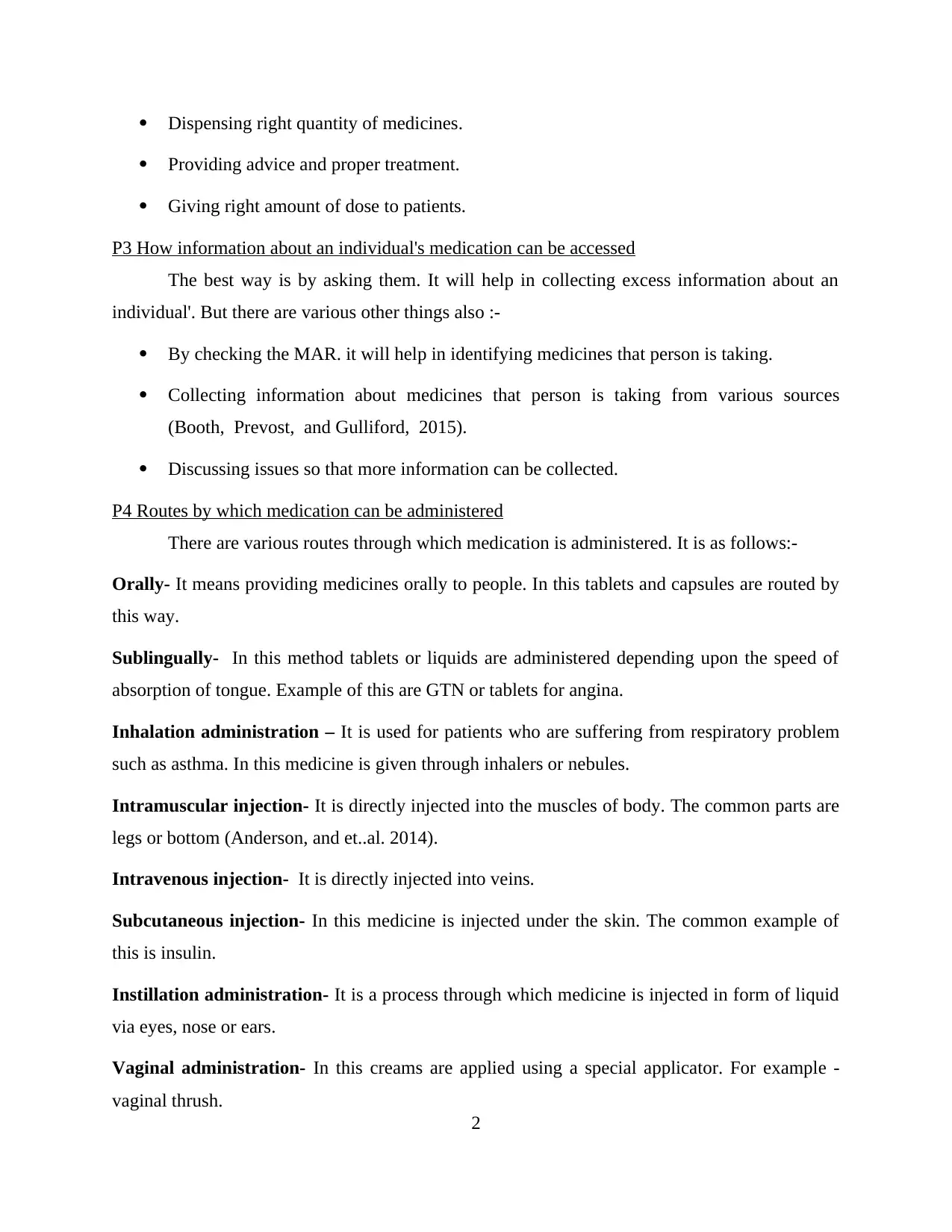
Dispensing right quantity of medicines.
Providing advice and proper treatment.
Giving right amount of dose to patients.
P3 How information about an individual's medication can be accessed
The best way is by asking them. It will help in collecting excess information about an
individual'. But there are various other things also :-
By checking the MAR. it will help in identifying medicines that person is taking.
Collecting information about medicines that person is taking from various sources
(Booth, Prevost, and Gulliford, 2015).
Discussing issues so that more information can be collected.
P4 Routes by which medication can be administered
There are various routes through which medication is administered. It is as follows:-
Orally- It means providing medicines orally to people. In this tablets and capsules are routed by
this way.
Sublingually- In this method tablets or liquids are administered depending upon the speed of
absorption of tongue. Example of this are GTN or tablets for angina.
Inhalation administration – It is used for patients who are suffering from respiratory problem
such as asthma. In this medicine is given through inhalers or nebules.
Intramuscular injection- It is directly injected into the muscles of body. The common parts are
legs or bottom (Anderson, and et..al. 2014).
Intravenous injection- It is directly injected into veins.
Subcutaneous injection- In this medicine is injected under the skin. The common example of
this is insulin.
Instillation administration- It is a process through which medicine is injected in form of liquid
via eyes, nose or ears.
Vaginal administration- In this creams are applied using a special applicator. For example -
vaginal thrush.
2
Providing advice and proper treatment.
Giving right amount of dose to patients.
P3 How information about an individual's medication can be accessed
The best way is by asking them. It will help in collecting excess information about an
individual'. But there are various other things also :-
By checking the MAR. it will help in identifying medicines that person is taking.
Collecting information about medicines that person is taking from various sources
(Booth, Prevost, and Gulliford, 2015).
Discussing issues so that more information can be collected.
P4 Routes by which medication can be administered
There are various routes through which medication is administered. It is as follows:-
Orally- It means providing medicines orally to people. In this tablets and capsules are routed by
this way.
Sublingually- In this method tablets or liquids are administered depending upon the speed of
absorption of tongue. Example of this are GTN or tablets for angina.
Inhalation administration – It is used for patients who are suffering from respiratory problem
such as asthma. In this medicine is given through inhalers or nebules.
Intramuscular injection- It is directly injected into the muscles of body. The common parts are
legs or bottom (Anderson, and et..al. 2014).
Intravenous injection- It is directly injected into veins.
Subcutaneous injection- In this medicine is injected under the skin. The common example of
this is insulin.
Instillation administration- It is a process through which medicine is injected in form of liquid
via eyes, nose or ears.
Vaginal administration- In this creams are applied using a special applicator. For example -
vaginal thrush.
2
Secure Best Marks with AI Grader
Need help grading? Try our AI Grader for instant feedback on your assignments.
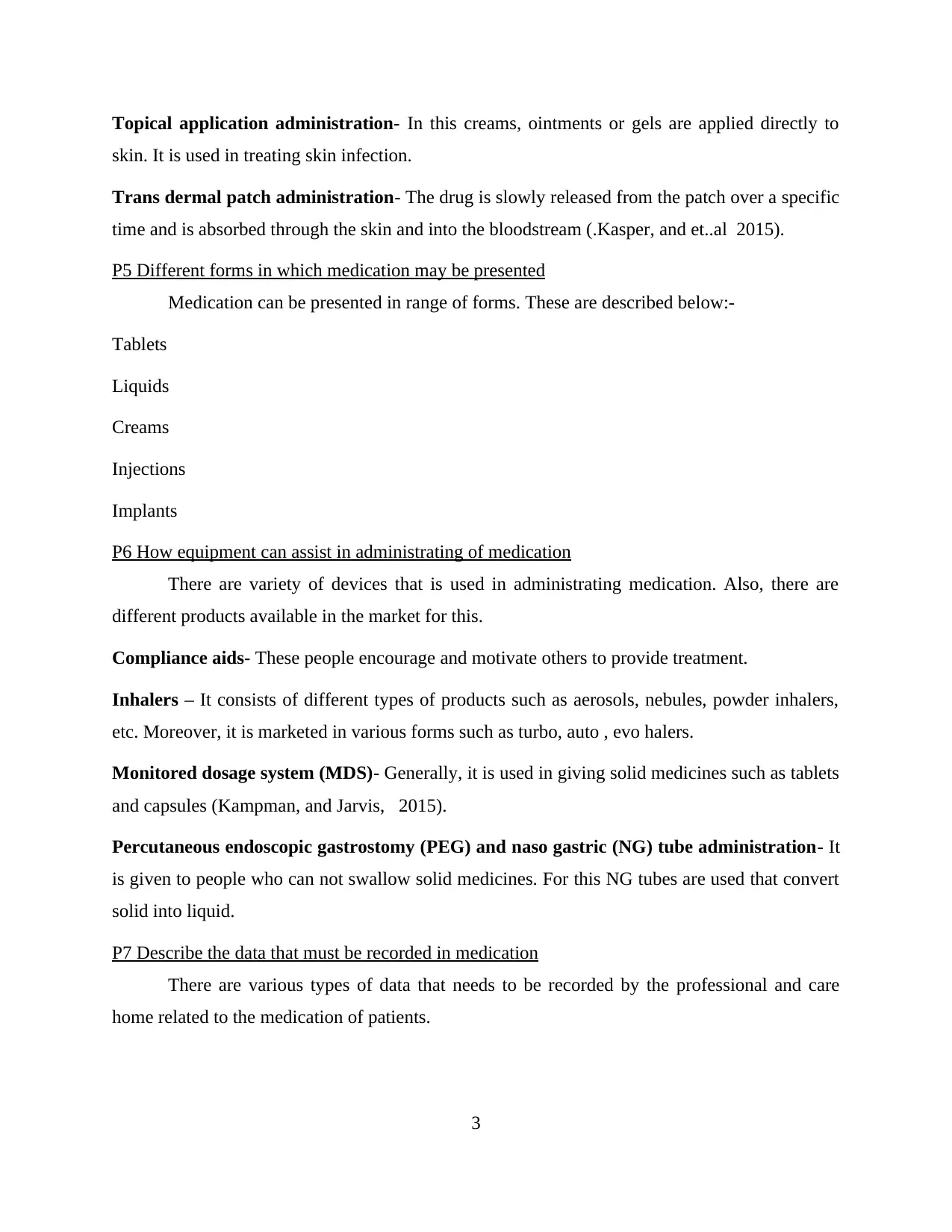
Topical application administration- In this creams, ointments or gels are applied directly to
skin. It is used in treating skin infection.
Trans dermal patch administration- The drug is slowly released from the patch over a specific
time and is absorbed through the skin and into the bloodstream (.Kasper, and et..al 2015).
P5 Different forms in which medication may be presented
Medication can be presented in range of forms. These are described below:-
Tablets
Liquids
Creams
Injections
Implants
P6 How equipment can assist in administrating of medication
There are variety of devices that is used in administrating medication. Also, there are
different products available in the market for this.
Compliance aids- These people encourage and motivate others to provide treatment.
Inhalers – It consists of different types of products such as aerosols, nebules, powder inhalers,
etc. Moreover, it is marketed in various forms such as turbo, auto , evo halers.
Monitored dosage system (MDS)- Generally, it is used in giving solid medicines such as tablets
and capsules (Kampman, and Jarvis, 2015).
Percutaneous endoscopic gastrostomy (PEG) and naso gastric (NG) tube administration- It
is given to people who can not swallow solid medicines. For this NG tubes are used that convert
solid into liquid.
P7 Describe the data that must be recorded in medication
There are various types of data that needs to be recorded by the professional and care
home related to the medication of patients.
3
skin. It is used in treating skin infection.
Trans dermal patch administration- The drug is slowly released from the patch over a specific
time and is absorbed through the skin and into the bloodstream (.Kasper, and et..al 2015).
P5 Different forms in which medication may be presented
Medication can be presented in range of forms. These are described below:-
Tablets
Liquids
Creams
Injections
Implants
P6 How equipment can assist in administrating of medication
There are variety of devices that is used in administrating medication. Also, there are
different products available in the market for this.
Compliance aids- These people encourage and motivate others to provide treatment.
Inhalers – It consists of different types of products such as aerosols, nebules, powder inhalers,
etc. Moreover, it is marketed in various forms such as turbo, auto , evo halers.
Monitored dosage system (MDS)- Generally, it is used in giving solid medicines such as tablets
and capsules (Kampman, and Jarvis, 2015).
Percutaneous endoscopic gastrostomy (PEG) and naso gastric (NG) tube administration- It
is given to people who can not swallow solid medicines. For this NG tubes are used that convert
solid into liquid.
P7 Describe the data that must be recorded in medication
There are various types of data that needs to be recorded by the professional and care
home related to the medication of patients.
3
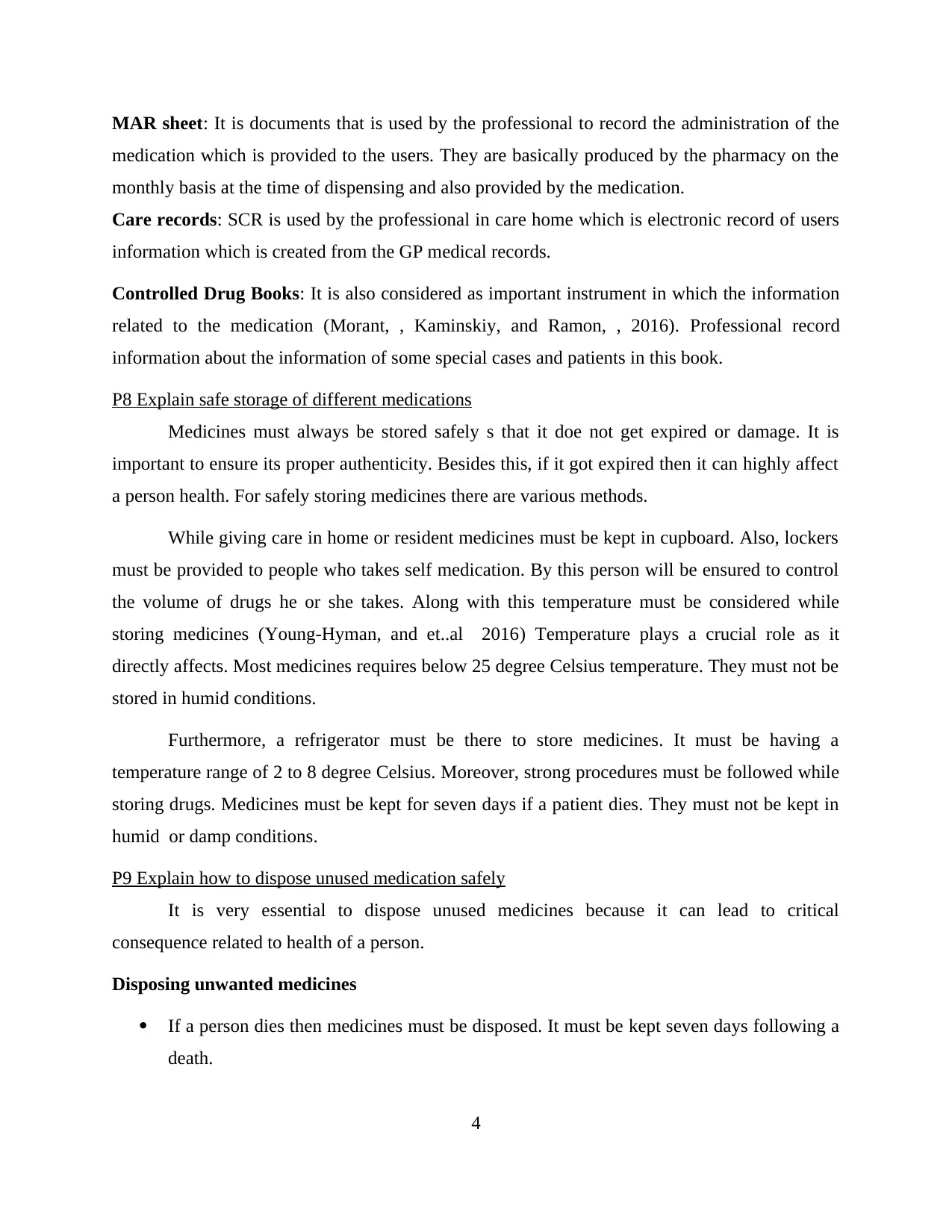
MAR sheet: It is documents that is used by the professional to record the administration of the
medication which is provided to the users. They are basically produced by the pharmacy on the
monthly basis at the time of dispensing and also provided by the medication.
Care records: SCR is used by the professional in care home which is electronic record of users
information which is created from the GP medical records.
Controlled Drug Books: It is also considered as important instrument in which the information
related to the medication (Morant, , Kaminskiy, and Ramon, , 2016). Professional record
information about the information of some special cases and patients in this book.
P8 Explain safe storage of different medications
Medicines must always be stored safely s that it doe not get expired or damage. It is
important to ensure its proper authenticity. Besides this, if it got expired then it can highly affect
a person health. For safely storing medicines there are various methods.
While giving care in home or resident medicines must be kept in cupboard. Also, lockers
must be provided to people who takes self medication. By this person will be ensured to control
the volume of drugs he or she takes. Along with this temperature must be considered while
storing medicines (Young-Hyman, and et..al 2016) Temperature plays a crucial role as it
directly affects. Most medicines requires below 25 degree Celsius temperature. They must not be
stored in humid conditions.
Furthermore, a refrigerator must be there to store medicines. It must be having a
temperature range of 2 to 8 degree Celsius. Moreover, strong procedures must be followed while
storing drugs. Medicines must be kept for seven days if a patient dies. They must not be kept in
humid or damp conditions.
P9 Explain how to dispose unused medication safely
It is very essential to dispose unused medicines because it can lead to critical
consequence related to health of a person.
Disposing unwanted medicines
If a person dies then medicines must be disposed. It must be kept seven days following a
death.
4
medication which is provided to the users. They are basically produced by the pharmacy on the
monthly basis at the time of dispensing and also provided by the medication.
Care records: SCR is used by the professional in care home which is electronic record of users
information which is created from the GP medical records.
Controlled Drug Books: It is also considered as important instrument in which the information
related to the medication (Morant, , Kaminskiy, and Ramon, , 2016). Professional record
information about the information of some special cases and patients in this book.
P8 Explain safe storage of different medications
Medicines must always be stored safely s that it doe not get expired or damage. It is
important to ensure its proper authenticity. Besides this, if it got expired then it can highly affect
a person health. For safely storing medicines there are various methods.
While giving care in home or resident medicines must be kept in cupboard. Also, lockers
must be provided to people who takes self medication. By this person will be ensured to control
the volume of drugs he or she takes. Along with this temperature must be considered while
storing medicines (Young-Hyman, and et..al 2016) Temperature plays a crucial role as it
directly affects. Most medicines requires below 25 degree Celsius temperature. They must not be
stored in humid conditions.
Furthermore, a refrigerator must be there to store medicines. It must be having a
temperature range of 2 to 8 degree Celsius. Moreover, strong procedures must be followed while
storing drugs. Medicines must be kept for seven days if a patient dies. They must not be kept in
humid or damp conditions.
P9 Explain how to dispose unused medication safely
It is very essential to dispose unused medicines because it can lead to critical
consequence related to health of a person.
Disposing unwanted medicines
If a person dies then medicines must be disposed. It must be kept seven days following a
death.
4
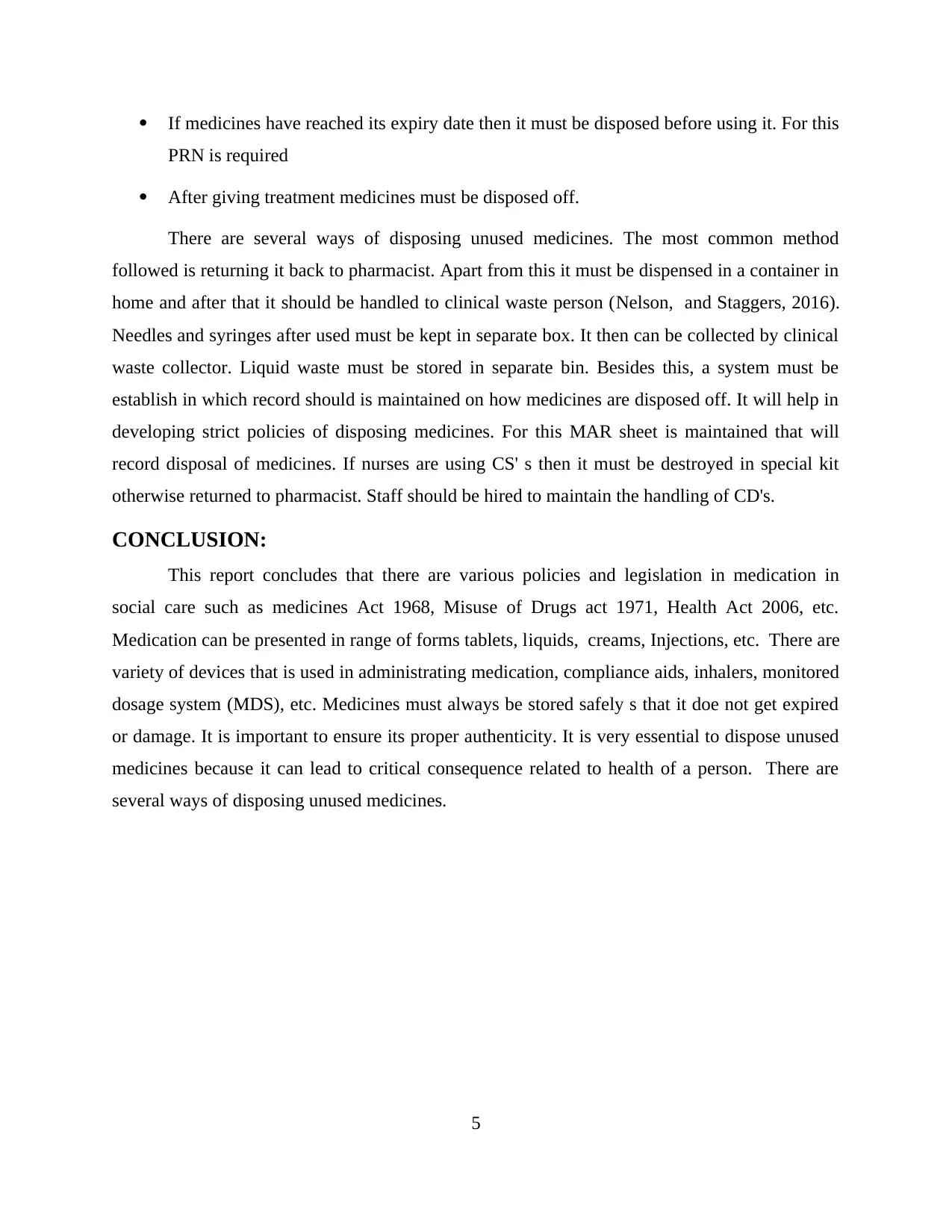
If medicines have reached its expiry date then it must be disposed before using it. For this
PRN is required
After giving treatment medicines must be disposed off.
There are several ways of disposing unused medicines. The most common method
followed is returning it back to pharmacist. Apart from this it must be dispensed in a container in
home and after that it should be handled to clinical waste person (Nelson, and Staggers, 2016).
Needles and syringes after used must be kept in separate box. It then can be collected by clinical
waste collector. Liquid waste must be stored in separate bin. Besides this, a system must be
establish in which record should is maintained on how medicines are disposed off. It will help in
developing strict policies of disposing medicines. For this MAR sheet is maintained that will
record disposal of medicines. If nurses are using CS' s then it must be destroyed in special kit
otherwise returned to pharmacist. Staff should be hired to maintain the handling of CD's.
CONCLUSION:
This report concludes that there are various policies and legislation in medication in
social care such as medicines Act 1968, Misuse of Drugs act 1971, Health Act 2006, etc.
Medication can be presented in range of forms tablets, liquids, creams, Injections, etc. There are
variety of devices that is used in administrating medication, compliance aids, inhalers, monitored
dosage system (MDS), etc. Medicines must always be stored safely s that it doe not get expired
or damage. It is important to ensure its proper authenticity. It is very essential to dispose unused
medicines because it can lead to critical consequence related to health of a person. There are
several ways of disposing unused medicines.
5
PRN is required
After giving treatment medicines must be disposed off.
There are several ways of disposing unused medicines. The most common method
followed is returning it back to pharmacist. Apart from this it must be dispensed in a container in
home and after that it should be handled to clinical waste person (Nelson, and Staggers, 2016).
Needles and syringes after used must be kept in separate box. It then can be collected by clinical
waste collector. Liquid waste must be stored in separate bin. Besides this, a system must be
establish in which record should is maintained on how medicines are disposed off. It will help in
developing strict policies of disposing medicines. For this MAR sheet is maintained that will
record disposal of medicines. If nurses are using CS' s then it must be destroyed in special kit
otherwise returned to pharmacist. Staff should be hired to maintain the handling of CD's.
CONCLUSION:
This report concludes that there are various policies and legislation in medication in
social care such as medicines Act 1968, Misuse of Drugs act 1971, Health Act 2006, etc.
Medication can be presented in range of forms tablets, liquids, creams, Injections, etc. There are
variety of devices that is used in administrating medication, compliance aids, inhalers, monitored
dosage system (MDS), etc. Medicines must always be stored safely s that it doe not get expired
or damage. It is important to ensure its proper authenticity. It is very essential to dispose unused
medicines because it can lead to critical consequence related to health of a person. There are
several ways of disposing unused medicines.
5
Paraphrase This Document
Need a fresh take? Get an instant paraphrase of this document with our AI Paraphraser
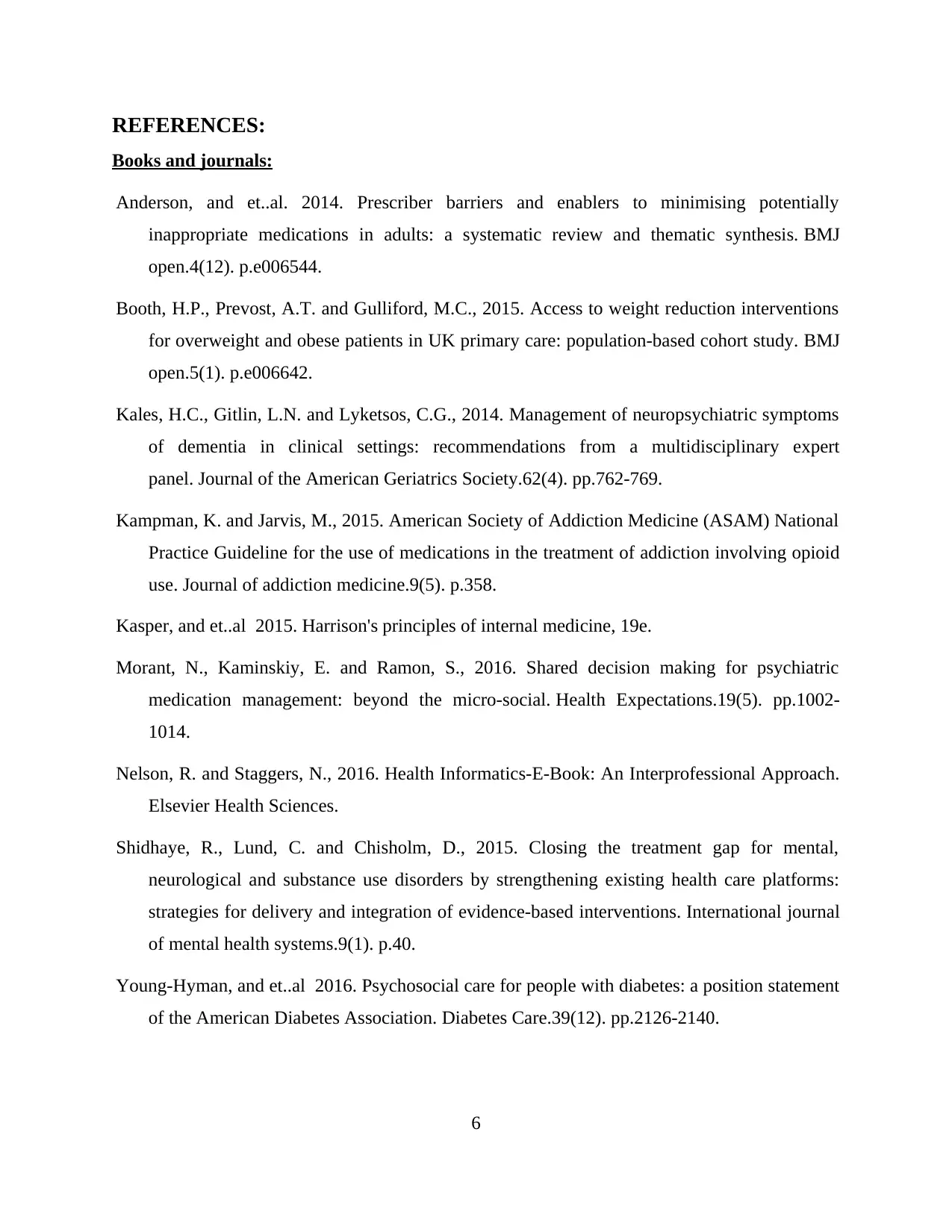
REFERENCES:
Books and journals:
Anderson, and et..al. 2014. Prescriber barriers and enablers to minimising potentially
inappropriate medications in adults: a systematic review and thematic synthesis. BMJ
open.4(12). p.e006544.
Booth, H.P., Prevost, A.T. and Gulliford, M.C., 2015. Access to weight reduction interventions
for overweight and obese patients in UK primary care: population-based cohort study. BMJ
open.5(1). p.e006642.
Kales, H.C., Gitlin, L.N. and Lyketsos, C.G., 2014. Management of neuropsychiatric symptoms
of dementia in clinical settings: recommendations from a multidisciplinary expert
panel. Journal of the American Geriatrics Society.62(4). pp.762-769.
Kampman, K. and Jarvis, M., 2015. American Society of Addiction Medicine (ASAM) National
Practice Guideline for the use of medications in the treatment of addiction involving opioid
use. Journal of addiction medicine.9(5). p.358.
Kasper, and et..al 2015. Harrison's principles of internal medicine, 19e.
Morant, N., Kaminskiy, E. and Ramon, S., 2016. Shared decision making for psychiatric
medication management: beyond the micro‐social. Health Expectations.19(5). pp.1002-
1014.
Nelson, R. and Staggers, N., 2016. Health Informatics-E-Book: An Interprofessional Approach.
Elsevier Health Sciences.
Shidhaye, R., Lund, C. and Chisholm, D., 2015. Closing the treatment gap for mental,
neurological and substance use disorders by strengthening existing health care platforms:
strategies for delivery and integration of evidence-based interventions. International journal
of mental health systems.9(1). p.40.
Young-Hyman, and et..al 2016. Psychosocial care for people with diabetes: a position statement
of the American Diabetes Association. Diabetes Care.39(12). pp.2126-2140.
6
Books and journals:
Anderson, and et..al. 2014. Prescriber barriers and enablers to minimising potentially
inappropriate medications in adults: a systematic review and thematic synthesis. BMJ
open.4(12). p.e006544.
Booth, H.P., Prevost, A.T. and Gulliford, M.C., 2015. Access to weight reduction interventions
for overweight and obese patients in UK primary care: population-based cohort study. BMJ
open.5(1). p.e006642.
Kales, H.C., Gitlin, L.N. and Lyketsos, C.G., 2014. Management of neuropsychiatric symptoms
of dementia in clinical settings: recommendations from a multidisciplinary expert
panel. Journal of the American Geriatrics Society.62(4). pp.762-769.
Kampman, K. and Jarvis, M., 2015. American Society of Addiction Medicine (ASAM) National
Practice Guideline for the use of medications in the treatment of addiction involving opioid
use. Journal of addiction medicine.9(5). p.358.
Kasper, and et..al 2015. Harrison's principles of internal medicine, 19e.
Morant, N., Kaminskiy, E. and Ramon, S., 2016. Shared decision making for psychiatric
medication management: beyond the micro‐social. Health Expectations.19(5). pp.1002-
1014.
Nelson, R. and Staggers, N., 2016. Health Informatics-E-Book: An Interprofessional Approach.
Elsevier Health Sciences.
Shidhaye, R., Lund, C. and Chisholm, D., 2015. Closing the treatment gap for mental,
neurological and substance use disorders by strengthening existing health care platforms:
strategies for delivery and integration of evidence-based interventions. International journal
of mental health systems.9(1). p.40.
Young-Hyman, and et..al 2016. Psychosocial care for people with diabetes: a position statement
of the American Diabetes Association. Diabetes Care.39(12). pp.2126-2140.
6
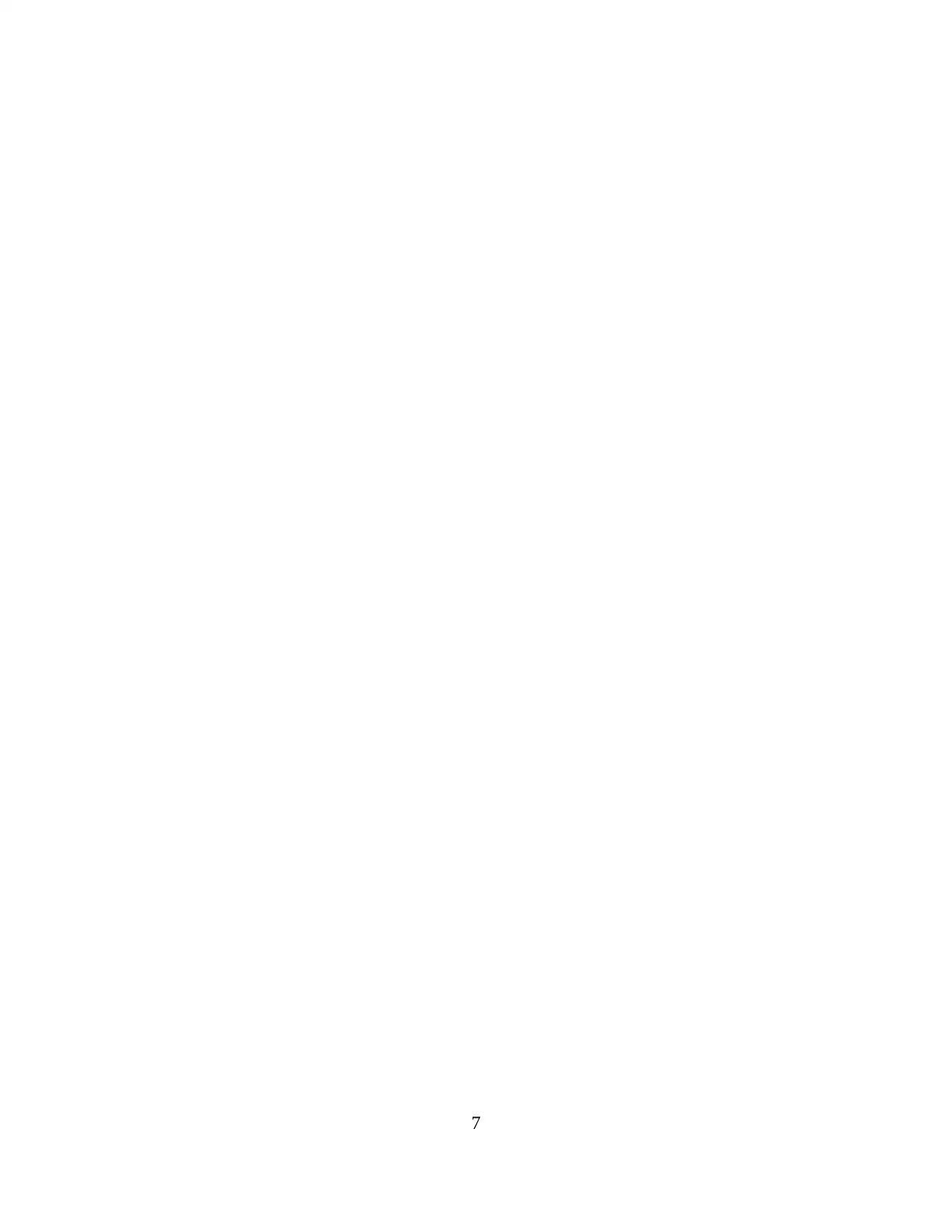
7
1 out of 9
Related Documents
Your All-in-One AI-Powered Toolkit for Academic Success.
+13062052269
info@desklib.com
Available 24*7 on WhatsApp / Email
![[object Object]](/_next/static/media/star-bottom.7253800d.svg)
Unlock your academic potential
© 2024 | Zucol Services PVT LTD | All rights reserved.





